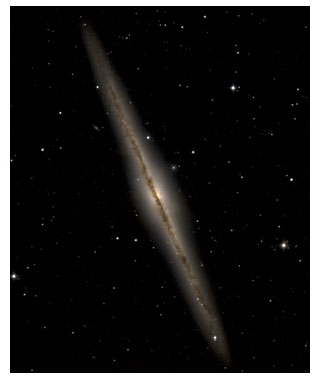HILO, Hawaii, Nov. 10 -- Astronomers from the University of Hawaii (UH) Institute for Astronomy have released the first image from a gigantic new 16-megapixel infrared camera recently mounted on the UH 2.2-meter (88-inch) telescope on Mauna Kea. The new camera provides a sixteen-fold increase in sky coverage and much higher sensitivity than the 1-megapixel cameras in widespread use on telescopes for the last decade. Until larger telescopes have similar cameras, this makes the 30-year-old UH 2.2-meter telescope the most powerful in the world for infrared (IR) imaging, the university said.

CUTTING-EDGE IMAGERY: A glimpse of the edge of a galaxy like ours. This color image was made from two separate infrared images at wavelengths of 1.2 and 1.6 microns. The total exposure time was approximately 30 minutes. (Photo: University of Hawaii)
This new technology was driven by the requirements of NASA's James Webb Space Telescope (JWST), the next step beyond the Hubble Space Telescope. This 6-meter-class space telescope -- with six times the collecting area of Hubble -- will be launched into an orbit far beyond the moon, where it will cool to temperatures of -400 degrees Fahrenheit, allowing extremely sensitive IR observations. NASA has selected the UH detector technology for the camera on JWST and is expected to adopt it for several other instruments.
Funded by a nearly $7 million award from NASA Ames Research Center, a team at the Institute for Astronomy's (IFA) Hilo facility, headed by Don Hall, former IFA director, is collaborating with Rockwell Scientific Co., of Camarillo, Calif., in a four-year program to develop 4-megapixel chips that use new IR detector materials and state-of-the-art silicon chips which, at nearly 2" x 2 inches, are some of the largest ever produced. In partnership with GL Scientific, a Honolulu small business, the team has innovated a new approach to mount the individual 4-megapixel chips so that four of them can be "tiled" into a 16-megapixel camera. This approach allows for even larger "mosaic" cameras in the future, the university said.
The galaxy in the image, NGC 891, is in the constellation Andromeda about 10 million light years away. It is of particular scientific interest, UH said, because it is very similar to our own Milky Way galaxy but is seen almost exactly edge-on. Richard Wainscoat and Peter Capak, who are analyzing the image, emphasized the importance of being able to image the entire galaxy in a single exposure with the new camera.
"With smaller cameras, galaxies such as NGC 891 had to be imaged in small postage stamp sized pieces that had to be painstakingly pieced together -- the new camera produces a better image in a tiny fraction of the time," Wainscoat said. "By allowing us to image very large areas of the sky, this camera will allow us to detect some of the most distant galaxies in the universe."
Along with the JWST, large ground-based telescopes are already racing to take advantage of this new technology. Two Mauna Kea projects, the Canada-France-Hawaii Telescope and the Gemini Telescopes, are developing with 16-megapixel IR cameras, and Rockwell Scientific has orders for several other cameras for telescopes in Chile.
For more information, visit: www.ifa.hawaii.edu